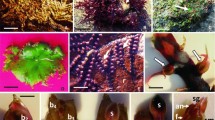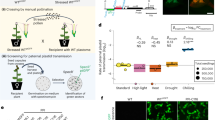Summary
The egg and central cells of Plumbago zeylanica have an average volume of 543,000 μm3 and 2,560,000 μm3 respectively, with surface areas of 38,600 μm2 and 154,000 μm2. The egg contains an average of 39,900 mitochondria and 730 plastids. The majority of the plastids are perinuclear (> 60%) with less than 40% in lateral areas or near the filiform apparatus. After fertilization, the number of maternal organelles exceeds paternal organelles by a ratio of 1∶1,000 for mitochondria and 1∶54 for plastids. The central cell contains an average of 178,700 mitochondria and 1,840 plastids. After fertilization, these organelles far exceed the number of sperm organelles transmitted, by a ratio of approx. 1∶4,000 for plastids and 1∶820 for mitochondria. Biparental inheritance of plastids in the embryo is possible, but not favored; the only comparable data in Oenothera and Impatiens reveals that biparental inheritance is possible in up to 1∶24 ratios. Plants lacking biparental plastid inheritance do not contain plastids in the sperm, and thus the presence of even few sperm plastids may result in expression. The number of paternal mitochondria transmitted into the central cell is greater than that transmitted into the egg as the result of preferential fertilization with the mitochondrion-rich dimorphic sperm cell, although the ratio of paternal to maternal mitochondria is 1∶1,000 in the egg and 1∶820 in the central cell. The similarity in these ratios suggests that there is a critical dosage of mitochondria that is permissible within the zygotic and endospermatic lineages. This may represent either: (1) a maximum permissible value to prevent expression of paternal mitochondrial genome, (2) a minimum ratio required in order to permit recombination of maternal and paternal mitochondrial genomes, or (3) a cytoplasmic genome balance number.
Similar content being viewed by others
Abbreviations
- mtDNA:
-
mitochondrial DNA
- Sua :
-
sperm cell unassociated with the vegetative nucleus
- Svn :
-
sperm cell physically associated with the vegetative nucleus
References
Bendich AJ, Gauriloff LP (1984) Morphometric analysis of cucurbit mitochondria: the relationship between chondriome volume and DNA content. Protoplasma 119:1–7
Birky CW (1978) Transmission genetics of mitochondria and chloroplasts. Annu Rev Genet 12:471–512
Birky CW (1983) Relaxed cellular controls and organelle heredity. Science 222:466–475
Birky CW, Maruyama T, Fuerst P (1983) An approach to population and evolutionary genetic theory for genes in mitochondria and chloroplasts, and some results. Genetics 103:513–527
Cass DD, Karas I (1974) Ultrastructural organization of the egg of Plumbago zeylanica. Protoplasma 81:49–62
Cruz Orive LM (1978) Particle size-shape distributions: the general spheroid problem. II. Stochastic model and practical guide. J Microsc (Oxford) 112:153–167
Dahlgren KVO (1937) Die Entwicklung des Embryosackes bei Plumbago zeylanica. Bot Not 487–497
Gillham NW (1978) Organelle heredity. Raven Press, New York
Grun P (1976) Cytoplasmic genetics and evolution. Columbia Press, New York
Gunning BES, Steer MW (1975) Ultrastructure and the biology of plant cells. Edward Arnold, London
Johnston SA, Nijs TPM, Peloquin SJ, Hanneman RE (1980) The significance of genic balance to endosperm development in interspecific crosses. Theor Appl Genet 57:5–9
Kirk JTO, Tilney-Bassett RAE (1978) The plastids, 2nd edn. Elsevier/North Holland, Amsterdam
Maheshwari P (1950) An introduction to the embryology of angiosperms. McGraw-Hill, New York
Meyer B, Stubbe W (1974) Das Zahlenverhältnis von mütterlichen und väterlichen Plastiden in den Zygoten von Oenothera erythrosepala Borbas (syn. Oe. lamarckiana). Ber Dtsch Bot Ges 87:29–38
McConchie CA, Russell SD, Dumas C, Tuohy M, Know RB (1987) Quantitative cytology of the sperm cells of Brassica campestris and B. oleracea. Planta 170:446–452
Mogensen HL, Rusche ML (1985) Quantitative analysis of barley sperm: occurrence and mechanism of cytoplasm and organelle reduction and the question of sperm dimorphism. Protoplasma 128:1–13
Pearson OH (1981) Nature and mechanism of cytoplasmic male sterility in plants: a review. Hort Science 16:482–487
Richter-Landmann W (1959) Der Befruchtungsvorgang bei Impatiens glandulifera Royle unter Berücksichtigung der plasmatischen Organelle von Spermzelle, Eizelle und Zygote. Planta 53:162–177
Russell SD (1981) Fertilization in Plumbago zeylanica: the structural basis of male cytoplasmic inheritance. Ph D Dissertation, University of Alberta, Edmonton, Canada
Russell SD (1982) Fertilization in Plumbago zeylanica: entry and discharge of the pollen tube into the embryo sac. Can J Bot 60:2219–2230
Russell SD (1983) Fertilization in Plumbago zeylanica: gametic fusion and fate of the male cytoplasm. Am J Bot 70:416–434
Russell SD (1984) Ultrastructure of the sperm of Plumbago zeylanica: 2. Quantitative cytology and three-dimensional reconstruction. Planta 162:385–391
Russell SD (1985) Preferential fertilization in Plumbago: ultrastructural evidence for gamete-level recognition in an angiosperm. Proc Natl Acad Sci USA 82:6129–6132
Russell SD (1986) Dimorphic sperm cells, cytoplasmic transmission, and preferential fertilization in Plumbago zeylanica. In: Mantell SH, Chapman GP, Street PFS (eds) The chondriome. Longman, London, pp 69–116
Russell SD, Cass DD (1981) Ultrastructure of the sperms of Plumbago zeylanica. 1. Cytology and association with the vegetative nucleus. Protoplasma 107:85–107
Spurr AR (1969) A new low viscosity epoxy resin embedding medium for electron microscopy. J Ultrastruct Res 26:31–43
Weibel ER (1979) Stereological methods, vol 1. Practical methods for biological morphometry. Academic Press, London
Weibel ER (1980) Stereological methods, vol 2. Theoretical foundations. Academic Press, London
Wilms, HJ (1986) Dimorphic sperm cells in the pollen grain of Spinacia. In: Cresti M, Dallai R (eds) Biology of reproduction and cell motility in plants and animals. University of Siena, Siena, Italy, pp 193–198
Author information
Authors and Affiliations
Additional information
Communicated by R. Hagemann
Rights and permissions
About this article
Cite this article
Russell, S.D. Quantitative cytology of the egg and central cell of Plumbago zeylanica and its impact on cytoplasmic inheritance patterns. Theoret. Appl. Genetics 74, 693–699 (1987). https://doi.org/10.1007/BF00247543
Received:
Accepted:
Issue Date:
DOI: https://doi.org/10.1007/BF00247543




